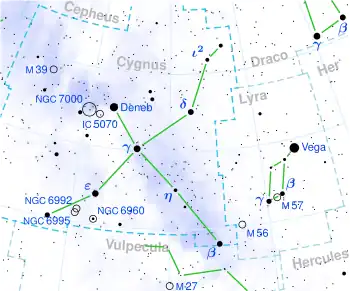 | |
| Observation data Epoch J2000.0 Equinox J2000.0 | |
|---|---|
| Constellation | Cygnus |
| Right ascension | 21h 14m 47.4916s |
| Declination | +38° 02′ 43.141″ |
| Apparent magnitude (V) | 3.65 - 3.75[1] (3.80 / 6.69[2]) |
| Characteristics | |
| Spectral type | F2 IV + G0 V |
| U−B color index | +0.03 / +0.09 |
| B−V color index | +0.38 / +0.60 |
| Variable type | δ Sct[1] |
| Astrometry | |
| Radial velocity (Rv) | -21.1 km/s |
| Proper motion (μ) | RA: 195.75 mas/yr Dec.: 410.03 mas/yr |
| Parallax (π) | 47.80 ± 0.61 mas |
| Distance | 68.2 ± 0.9 ly (20.9 ± 0.3 pc) |
| Orbit[3] | |
| Period (P) | 810 days |
| Semi-major axis (a) | 0.796 mas |
| Eccentricity (e) | 0.43 |
| Inclination (i) | 92.6° |
| Longitude of the node (Ω) | 78.7° |
| Periastron epoch (T) | 2453139.5 |
| Argument of periastron (ω) (secondary) | 90° |
| Details | |
| τ Cyg A | |
| Mass | 1.65[2] M☉ |
| Radius | 2.48[2] R☉ |
| Surface gravity (log g) | 3.87[2] cgs |
| Temperature | 6,600[2] K |
| Metallicity [Fe/H] | 0.05[2] dex |
| τ Cyg B | |
| Mass | 1.03[2] M☉ |
| Radius | 0.93[2] R☉ |
| Surface gravity (log g) | 4.52[2] cgs |
| Temperature | 5,670[2] K |
| Other designations | |
| Database references | |
| SIMBAD | data |
| A | |
| B | |
Tau Cygni, Latinised from τ Cygni, is a binary star system in the constellation Cygnus, approximately 69 light years away from Earth.[4] This visual binary system has a period of 49.6 years.[2]
The main star, 4th magnitude GJ 822.1 A, is a yellowish white subgiant star of the spectral type F2IV. It therefore has a surface temperature of 6,000 to 7,500 kelvins and is larger, hotter, and several times as bright as the Sun.[5] Its companion, 6th magnitude GJ 822.1 B, is a yellow main sequence star of the spectral type G0V. It is similar to the Sun in size, surface temperature, and luminosity.[6]
Tau Cygni is classified as a δ Scuti variable. The magnitude range is given as 3.65 to 3.75, which is the combined magnitude for both components, although the variable component is A.[1]
References
- 1 2 3 Samus, N. N.; Durlevich, O. V.; et al. (2009). "VizieR Online Data Catalog: General Catalogue of Variable Stars (Samus+ 2007-2013)". VizieR On-line Data Catalog: B/GCVS. Originally Published in: 2009yCat....102025S. 1: B/gcvs. Bibcode:2009yCat....102025S.
- 1 2 3 4 5 6 7 8 9 10 11 Fuhrmann, Klaus (February 2008), "Nearby stars of the Galactic disc and halo - IV", Monthly Notices of the Royal Astronomical Society, 384 (1): 173–224, Bibcode:2008MNRAS.384..173F, doi:10.1111/j.1365-2966.2007.12671.x
- ↑ "Sixth Catalog of Orbits of Visual Binary Stars". Archived from the original on 2017-08-01. Retrieved 2016-12-26.
- ↑ "* tau Cyg". SIMBAD. Centre de données astronomiques de Strasbourg. Retrieved October 18, 2007.
- ↑ "* tau Cyg A". SIMBAD. Centre de données astronomiques de Strasbourg. Retrieved October 18, 2007.
- ↑ "* tau Cyg B". SIMBAD. Centre de données astronomiques de Strasbourg. Retrieved October 18, 2007.